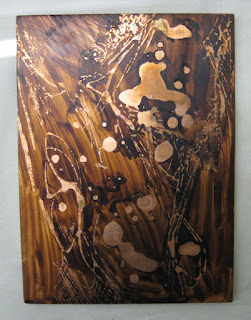Last week, I received a bunch of paper samples from a gentleman that did a talk about paper at The Drawing Studio on January 20th. He's a printmaker and works at a local art supply store,
Sarnoff. I used my small copper plate and black Akua ink in the Fabriano tests. Here is what I discovered so far.
First up, Fabriano Rosaspina in White and Ivory. No external sizing, 60% cotton rag, two deckle edges. Known as an underutilized printmaking paper; it has an excellent surface quality, a matte finish, and soaks up the ink like a sponge, and the ivory colored paper is really interesting. It's more tan than yellowish despite my shadowed and off-color photos. (I took the photos in my studio at night, so the lighting was pretty uneven). I really like this paper. I soaked it the recommended 30 minutes and it printed just beautifully This paper is a keeper. Interesting trivia: Italian paper mill
Fabriano was started in 1264 and was the first to harness water power for pulping.
 |
| Fabriano Rosaspina White |
 |
| Fabriano Rosaspina Ivory |
I also tried Fabriano Tiepolo. This paper is 100% cotton, has four deckle edges, and has a smoother surface. Apparently you can do almost anything with it but for printmaking, it is also excellent. Soak it for 30 minutes and it performs perfectly! Because of it's higher rag content, it should be exceptionally strong.
 |
| Fabriano Tiepolo Soft White |
Of these three Fabriano papers, I'm not sure which I like best...they are all really awesome papers! I will have to buy a few sheets of each and do further experiments such as try an oil-based ink and Solarplates.
Next up,
Awagami paper. I received a large sample pack of Awagami papers and only tested five of several papers that were recommended for printmaking. The sample sheets were smaller, so I used a Solarplate and Akua ink for testing. These are Japanese papers (washi), so they are made of either bamboo or mulbery (kozo). Some of the papers in the sampler were for sumi, watercolor, drawing, etc. and had unusual textures and colors. I just focused on the printmaking papers.
Don't call these rice papers though...there is no such thing. The Japanese do not make paper from rice, never have.
Top three prints, left to right:
Bamboo paper printmaking, 170g/m
3, soaked for 5 minutes
Kitakata HM, 100g/m
3, dipped in water
Shiramine NM-5, 110g/m
3, soaked for 2 minutes
Bottom two prints, left to right:
Bunkoshi, 70g/m
3, dipped in water
Bamboo paper printmaking, 250g/m
3, soaked for 10 minutes
The labels of each are shown on the front, but I actually printed on the correct side of the paper, so I did a little photoshopping so you can see the label on the front.
 |
| Backside of the Awagami paper tests |
You can see the labels on the back on the photo above. I'm showing the back so you can see how thin some of the papers are. A few are little too thin for my taste. My favorite paper of this bunch was the heavy bamboo paper 250g/m
3 on the bottom right. It works beautifully after only 10 minutes soaking. The nice thing I noticed about the bamboo paper is that you can see when it's fully saturated with water. It soaks it up and actually changes color a bit. The soaking times for each sample were figured out on my own according to weight. The papers that were very thin, I quickly dipped into the water but a spray bottle would be even better. I have more paper to test, so look for more Awagami experiments. I have no idea how much any of these papers are but I will go to Sarnoff and see. They are definitely worth checking out.
Tomorrow I'm going to be teaching the Solarplate class to the non-toxic printmaking students. I will take photos of course. Wish me luck!
~Rebecca





























